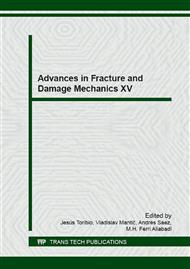p.143
p.147
p.151
p.155
p.159
p.163
p.167
p.171
p.175
Effect of Side Grooves on Plane Stress Fracture Behavior of Compact Tension Specimens Made of Ultra-High Strength Steel
Abstract:
Thin compact tension specimens made of direct quenched ultra-high strength steel were tested under constant rate uniaxial tensile load. The length of the crack was monitored using optical microscopes on both sides of the specimens during the fatigue pre-cracking (using a chevron V-notch). Deformations during the crack lengthening were recorded by a full-field measurement technique using a set of digital cameras to check the effect of side grooves on reduction of surface deformation. The Specimen without side grooves showed a high level of plasticity, thickness reduction, and crack growth along a deviating path. In addition, the fracture surface showed excessive failure along the inclined plane. The presence of side grooves, however, led to the decrease of the maximum applied force at final fracture while the force prior to crack tearing was almost the same as the specimen without side grooves. Grooves significantly reduced the inclination of the fracture plane and plastic deformation due to removal of low stress triaxiality on the surface. They led to the fracture along a straight path and approximately even surface which makes them beneficial especially when compliance method is used in plane stress fracture tests.
Info:
Periodical:
Pages:
159-162
Citation:
Online since:
September 2016
Price:
Сopyright:
© 2016 Trans Tech Publications Ltd. All Rights Reserved
Share:
Citation:


